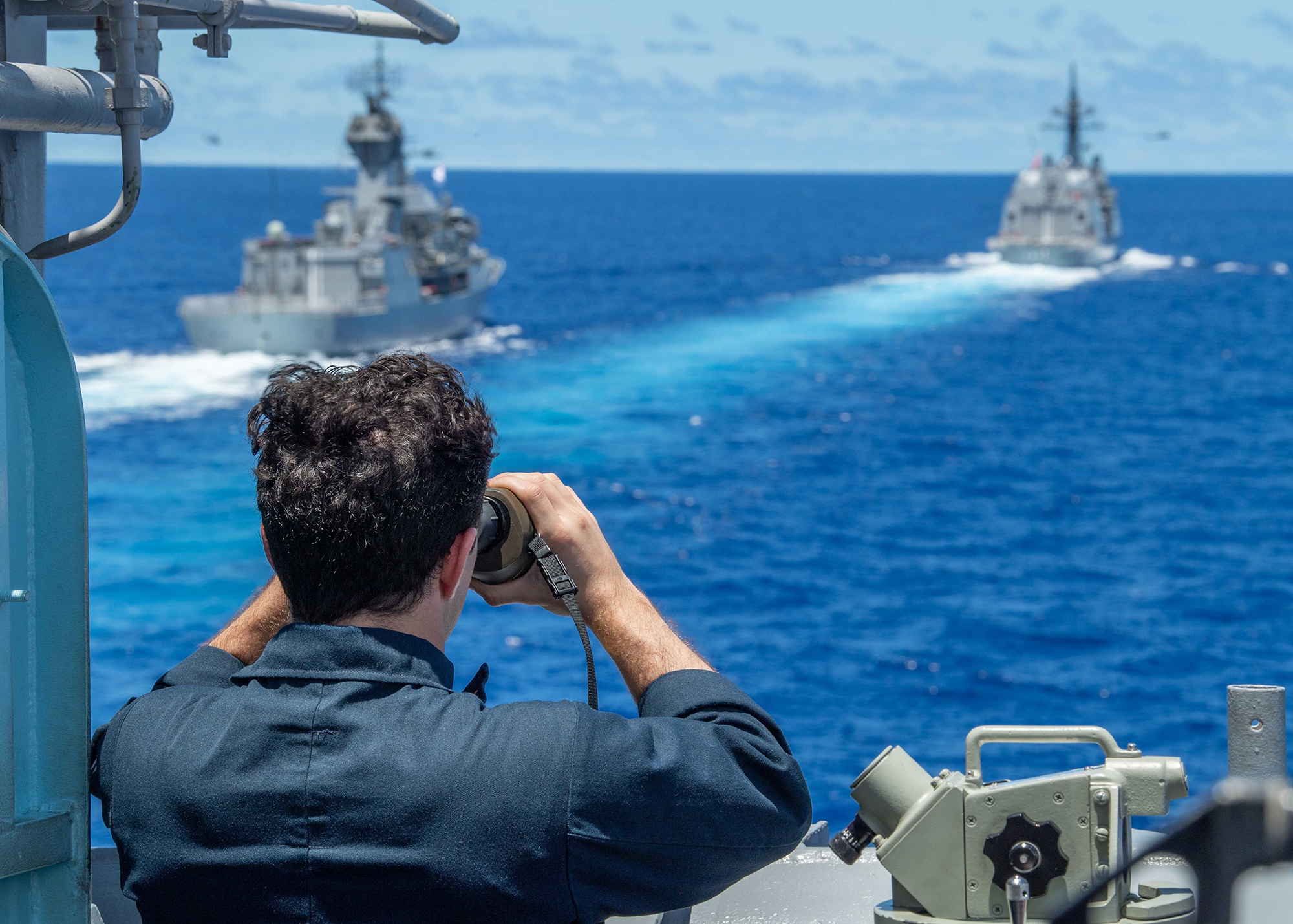

Paradox of Militarization: An Escalating Tension in the South China Sea
Rising tensions in the South China Sea spark geopolitical frictions. China’s assertive stance clashes with U.S. alliances, escalating risks and regional security concerns.
By | Tuo Jin,
JULY 03, 2024 | 02:14 PM

The first few months of 2024 have witnessed sudden rises of tensions in the South China Sea, evident by direct confrontations between China and the Philippines, continual maritime incidents as well as multilayered military drills. Amid persistently land reclamation and geopolitical chaos, military rivalry is expected to become more of a hot issue, pushing the South China Sea dispute to a new flashpoint.
Regarded as a geopolitical giant, China is currently criticized by its increasing strategic actions, primarily undertaken by the China Coast Guard (CCG) the People’s Armed Forces Maritime Militia (PAFMM). Recent conflicts underscore this ‘militarization’ trend. In March, it was reported that the CCG used water cannons in the process of intercepting Philippine resupply vessels near the Scarborough Shoal. Subsequently, China enforced its hard-line stance through military activities, for instance combat patrols and drills, in response to “provocations by the United States, the Philippines and others”. In that case, the strategic uncertainty of geopolitical giants and the rising display of military force have sparked widespread concern and even panic in the region.
The Paradox of “Militarization”
To start with, the Philippines has emerged as the strongest supporter of the U.S. among ASEAN member states. It is acknowledged to some extent that the core of the South China Sea dispute has shifted to Sino-U.S. rivalry. The 2023 U.S.-Philippines Bilateral Defense Guidelines marked a significant progress in terms of bilateral military alliance, which laid the foundation for further anti-China cooperation within the framework of U.S.-led alliance network.
The concept “militarization” was first brought up to the table of the South China Sea issue by the Philippines. In 1994, then president Fidel Valdez Ramos proposed the idea of “demilitarization” of related islands and reefs, in order to support joint exploitation of natural resources. This term wasn’t used as a discourse weapon until the U.S. took over. In October 2015, Gary Roughead, former Chief of Naval Operations of the United States, formally introduced the concept of ‘militarization’ of the South China Sea at the Sixth Xiangshan Forum in Beijing.
This concept immediately became a target for international criticisms against China and has remained a main tool of international opinion until now. Specifically, “militarization” refers to the process by which something takes on characteristics and functions for military purposes; if anything is used for military purposes, it is considered militarized, according to the U.S. version of this term. It is notable that the U.S., the Philippines and other allies use systematic public disclosure of China’s activities as well as regional dynamics to draw international attention, depicting China as a militarized opponent—“Threat of the Century”.
On the contrary, however, the Chinese government counters this definition severely and condemns the U.S. along with the Philippines as “discourse hegemony”. From the Chinese perspective, so-called “militarization” identifies all legitimate actions within the scope of sovereignty as militarized, including infrastructure construction, regular patrols, lawful military deployment, etc. Following this logic, China argues that all of its activities in the South China Sea cannot be regarded as preparatory work for military conflicts or intentional threats. These actions are described instead as the rights-defense-stability-
In such a complex context where definitions of military actions are vague, the term “militarization” has easily turned into a politically manipulative topic. Therefore, evaluating the strategic intentions and potential risks of different stakeholders is relatively tricky. Due to the absence of a uniform definition, each party has much autonomy to determine and interpret its own actions, especially in terms of military activities.
Potential Risks to Regional Security
Dotted with disputes, arguments and propaganda, the South China Sea has become a cauldron of geopolitical frictions. Escalating misjudgment and cynicism among involving states is altering the regional security landscape. In simpler terms, strategic activities conducted by geopolitical giants are imposing significant pressure on all other states.
The rise of Xi Jinping to the leadership of the Chinese Communist Party (CCP) is often seen as a pivotal moment for China’s approach to maritime disputes in the South China Seas. Since 2013, China’s stance has shifted from passive to assertive in defending its claims. Under Xi, the state’s maritime policy has focused on three main elements: the goal of become a “maritime great power”, the principle of “unity of rights defense and stability maintenance”, and a firm stance of “no acceptance, no participation, no recognition, no implementation” regarding the arbitration case brought by the Philippines under the UN Convention on the Law of the Sea (UNCLOS).
Simultaneously, China facilitates its policies through strengthening military build-ups, increasing the uncertainty of regional security. In late April this year, Chinese warships have twice approached and monitored the U.S.-Philippines annual “Balikatan” exercise. A month later, China announced a six-day military training ban in the South China Sea, prohibiting all non-military vessels from entering the area. This decision apparently serves as a clear warning to its neighboring countries.
Meanwhile, a pile of geopolitical dynamics has made the situation worse. Currently, the U.S. is constructing a more stable alliance network in the region by strengthening bilateral and multilateral relationships. From the Obama administration’s “dual-track policy” to Trump’s “coercive deterrence” and then to the Biden’s “integrated deterrence”, the States has distributed more attention on its appearance in South China Sea issues. Only five months into 2024, the United States has already launched several large-scale joint military exercises with its allies, including the Philippines, Japan, Australia and so on. Additionally, the approach of U.S. warships and aircraft carriers is also seen by the Chinese side as provocation and military threat. Consequently, it is relatively inaccurate to identify which side is the first to blame.
But one thing is clear: tensions are spreading throughout the region, posing panic on less powerful states, and disturbing regional military balance. Smaller nations like Vietnam and Malaysia find themselves increasingly vulnerable, potentially sparking a regional arms race as these countries bolster their own defenses in response. ASEAN member states are drowning into the dilemma of taking sides. On the one hand, most of them are tied to China economically and receiving much benefit from China’s economic foreign policies. On the other, they are facing the increasing uncertainty of threat and control from either China (in spite of its claim of “peaceful rise”) or the U.S.. As more powers enter the stage, the region’s economic, diplomatic, and military relations are becoming increasingly complex and even risky.
Furthermore, these actions risk unintended military confrontations, as evidenced by various stand-offs and naval encounters, which significantly raise the stakes for potential conflicts. As the South China Sea dispute is garnering more attention as an international focus and a focal geopolitical contention, the escalation of military dynamics is gradually pushing regional military balance to a dangerous situation. According to the draft budget of China’s Two Sessions, the total budget for China’s defense expenditure in 2024 will be 1,665.54 billion yuan, an increase of 7.2% compared to 2023, which goals include responding to provocations by other countries in the South China Sea. China’s increased defense budget, therefore, is likely to heighten security concerns among neighboring countries, particularly those with territorial disputes in the South and East China Seas. This budget boost could prompt other countries to increase their own defense spending and eventually lead to an arms race.
The Contradiction of A Rule-based Order
To address the contradiction between legitimacy and illegitimacy, the legitimacy of China’s sovereignty in South China Sea is often denied by invoking international and regional rules, such as the United Nations Convention on the Law of the Sea (UNCLOS) and the results of the 2016 Hague Tribunal, which are used to argue the rationality of China’s claim of its “historical sovereignty”. Recent years have witnessed the intensification of legal disputes in the area. China has continued to assert its “nine-dash line” claim that covers most of the South China Sea, emphasizing its historical rights. International rules and laws are criticized by the Chinese side that they do not include the means to deal with acquisitions of islands and reefs as well as norms of historic rights.
What’s more, China justifies its military activities by proposing the vagueness of international laws and rules. Take the UNCLOS as an example. The UNCLOS does not provide explicit provisions regarding the innocent passage of warships. However, Section 3 of the convention clearly states that the rules on “innocent passage through territorial seas” apply to all ships, and Article 17 stipulates that “all states, whether coastal or landlocked, have the right of innocent passage through the territorial sea of other states.” If a warship engages in non-innocent passage, the coastal state may repel it but cannot detain it. From these provisions, it can be inferred that warships can engage in innocent passage, albeit narrowly defined. Therefore, the ambiguity of the UNCLOS regarding the innocent passage of warships leads to different interpretations and applications, which can cause conflicts.
In practice, jurisprudence disputes over military activities within exclusive economic zones, procedures for innocent passage through territorial seas, and so-called excessive maritime rights claims cannot be fully resolved by some international maritime laws alone, in the context of contradictory interpretations. China, in this case, is trying to find a balanced point where it is able to frame its restrained image in the South China Sea and prevents the situation from getting out of control.


